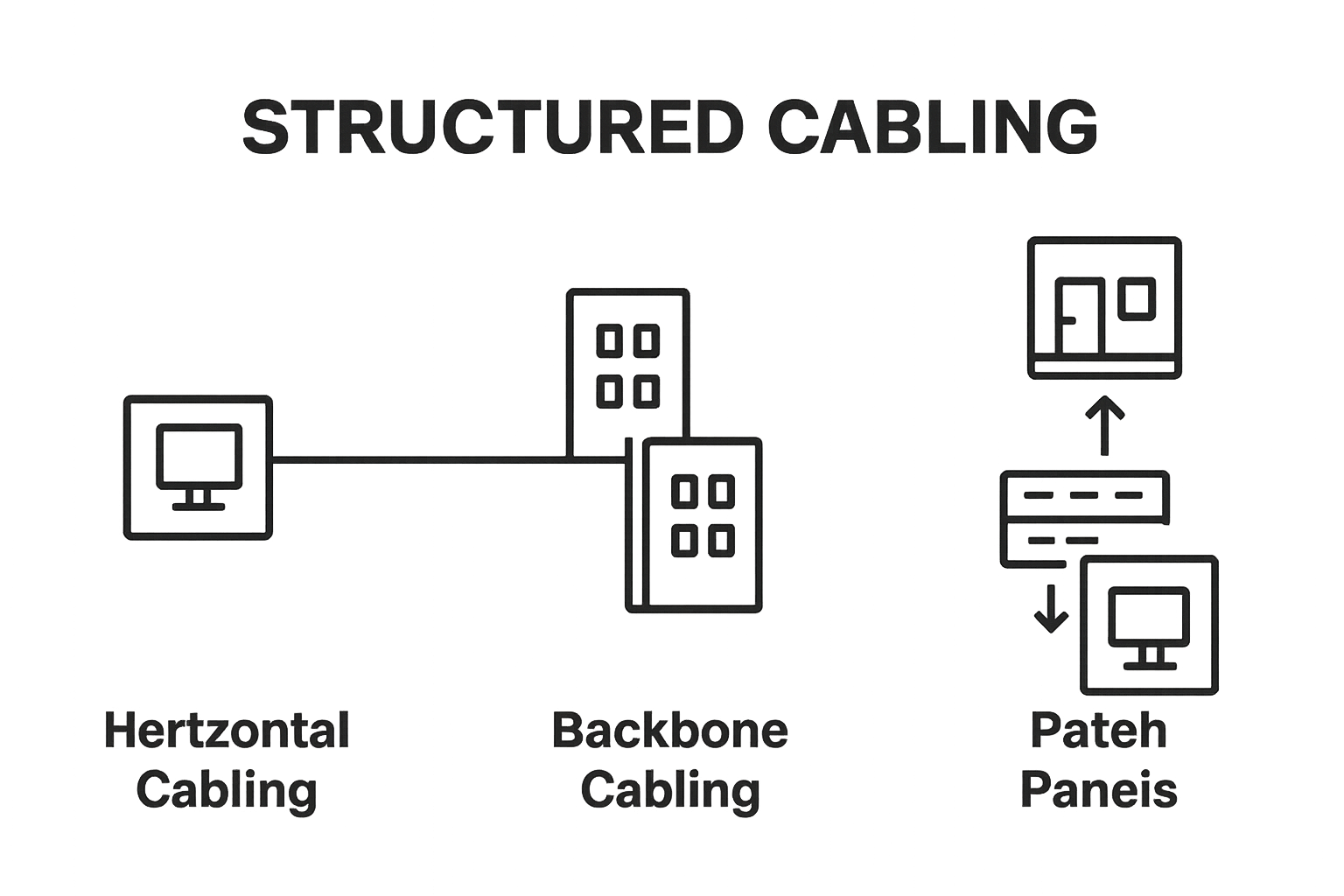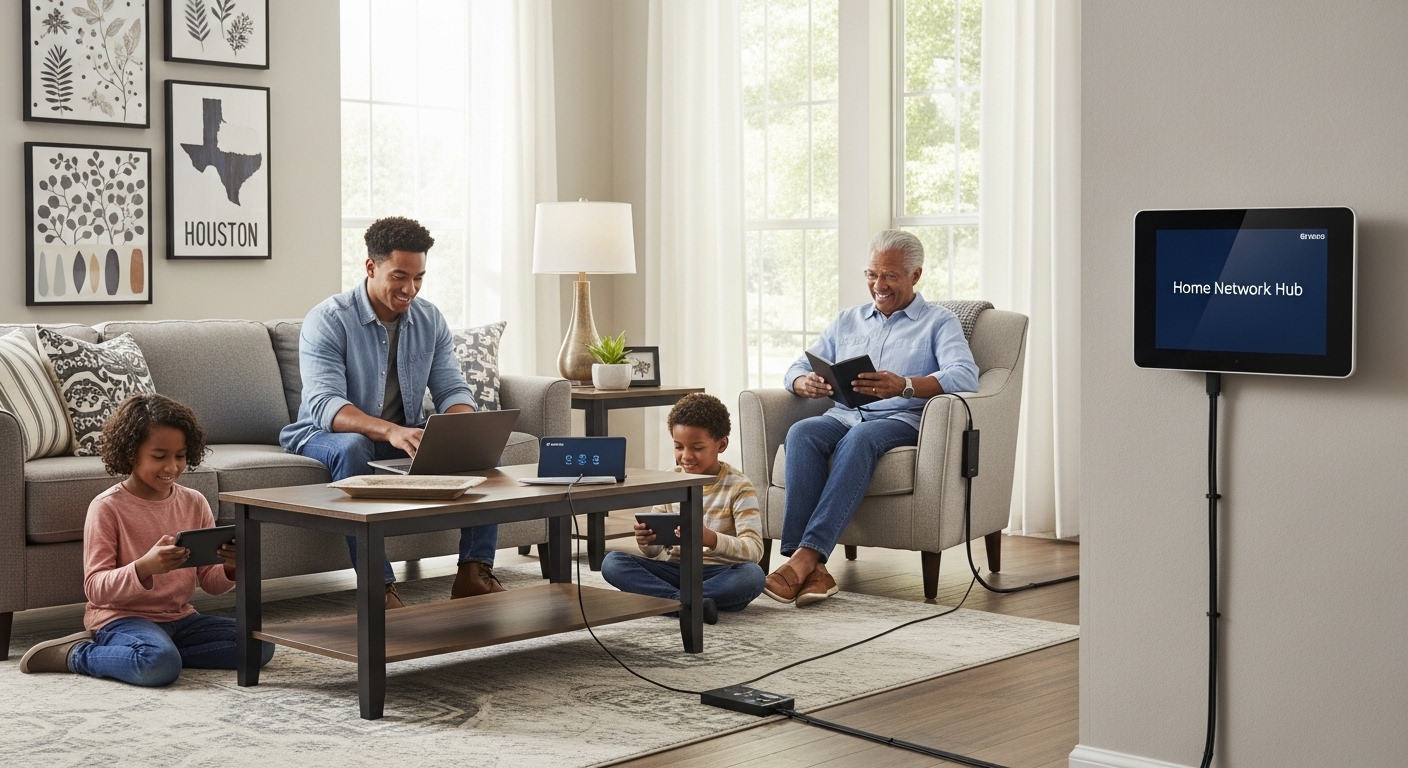What is Structured Cabling? A Complete Explanation
- garygarihanjr
- Sep 15
- 8 min read

Structured cabling systems are quietly transforming the way our homes and businesses stay connected. Nearly 70 percent of network downtime is traceable to poorly organized cabling infrastructure, which surprises many who thought technology hiccups came from hardware or software issues. Yet the real game begins when homes and offices adopt a systematic approach that not only fixes those hidden problems but actually prepares every room for whatever tech comes next.
Table of Contents
Quick Summary
Takeaway | Explanation |
Structured cabling creates organized network infrastructure. | It provides a standardized approach to managing data, voice, and video communications, enhancing reliability and efficiency. |
Future-proofing home technology is essential. | Proper structured cabling supports current and emerging technologies, helping to adapt to evolving digital ecosystems without major rewiring. |
High-speed data transmission improves user experiences. | Cable types like fiber optics ensure minimal interference and maintain consistent signal quality for demanding applications like streaming and gaming. |
Documentation and planning are crucial. | Keeping thorough records of network layouts and following industry standards facilitate easier maintenance and scalability of structured cabling systems. |
Professional installation impacts performance. | Quality installation practices, including proper cable management and environmental considerations, are vital for optimizing network performance and reliability. |
Defining Structured Cabling and Its Components
Structured cabling represents a comprehensive telecommunications infrastructure system that provides a standardized and organized approach to network connectivity. Unlike traditional point-to-point wiring methods, structured cabling creates a systematic framework for transmitting data, voice, and video signals across residential and commercial environments.
Below is a table summarizing the core components of a structured cabling system along with their primary functions, to help clarify their distinct roles in the network infrastructure.
Component | Description |
Horizontal Cabling | Connects telecommunication outlets to the network distribution center |
Backbone Cabling | Interconnects building entrance facilities, equipment rooms, and telecommunications rooms |
Patch Panels | Central connection points for routing network cables |
Patch Cords | Short cables used to connect equipment to the main network infrastructure |
Core Components of Structured Cabling
A structured cabling system consists of several critical components that work together to create a reliable network infrastructure. According to the North Carolina Department of Information Technology, these components typically include:
Horizontal Cabling: Connects telecommunication outlets to the network distribution center
Backbone Cabling: Interconnects building entrance facilities, equipment rooms, and telecommunications rooms
Patch Panels: Central connection points for routing network cables
Patch Cords: Short cables used to connect equipment to the main network infrastructure

Design and Architectural Principles
The architectural design of structured cabling follows specific standards that ensure scalability, performance, and future compatibility. These standards define how cables are organized, routed, and connected to provide maximum efficiency. Key design principles include modular organization, standardized cable types, and clear documentation of the entire network layout.
Structured cabling systems utilize various cable types such as copper twisted pair, coaxial, and fiber optic cables. Each cable type serves specific transmission requirements, with fiber optic cables offering superior performance for long-distance and high-bandwidth applications.
This table compares the different cable types used in structured cabling systems and highlights their associated benefits, making it easier to see which cable is suited for specific needs.
Cable Type | Typical Use Cases | Key Benefits |
Copper Twisted Pair | General data, voice, and video transmission | Cost-effective, widely compatible |
Coaxial | Television, internet, audio/video systems | Good for high-frequency signals, easy to install |
Fiber Optic | High-bandwidth, long-distance transmission | Superior speed, minimal interference |
By creating a uniform and organized network infrastructure, structured cabling enables businesses and residential spaces to maintain flexible, scalable, and reliable communication systems. The standardized approach reduces complexity, minimizes potential connectivity issues, and provides a clear pathway for future technological upgrades.
The Importance of Structured Cabling in Modern Homes
Structured cabling has transformed home network infrastructure by providing a comprehensive, organized approach to managing telecommunications and digital connectivity. As residential technology becomes increasingly complex, this systematic wiring solution offers homeowners unprecedented flexibility, reliability, and performance for their digital ecosystems.
Future-Proofing Home Technology
In the rapidly evolving landscape of home technology, structured cabling serves as a critical foundation for current and future connectivity needs. According to the ANSI/TIA/EIA 570A Residential Telecommunications Standard, residential wiring systems must be designed to support emerging services and technologies. Key advantages of structured cabling include:
Seamless integration of multiple communication technologies
Support for high-bandwidth applications
Simplified network management and expansion
Reduced long-term infrastructure modification costs
Performance and Reliability Benefits
Modern homes require robust network infrastructure capable of supporting multiple devices, streaming services, smart home technologies, and professional work environments. Structured cabling provides a standardized approach that ensures consistent signal quality, minimizes interference, and supports high-speed data transmission across various platforms.
The strategic design of structured cabling allows homeowners to create a centralized network hub that can accommodate everything from home entertainment systems and security networks to advanced home automation platforms. By implementing a well-designed structured cabling system, residents can achieve superior network performance, reduce potential connectivity issues, and create a more efficient digital environment.
Ultimately, structured cabling represents more than just a technical solution. It is an investment in a home’s technological infrastructure, enabling seamless connectivity, supporting emerging technologies, and providing a scalable framework for future digital innovations.
How Structured Cabling Works for Smart Automation
Structured cabling serves as the critical backbone for smart home automation systems, enabling seamless communication between various technological devices and networks. By providing a standardized, organized infrastructure, structured cabling transforms how residential technologies interact, communicate, and function together.
Network Communication Infrastructure
At its core, structured cabling creates a unified communication pathway that supports multiple smart home technologies simultaneously. According to the ANSI/TIA-862-C standard, this infrastructure supports intelligent building systems including security, energy management, and control networks. Key communication capabilities include:
Simultaneous data transmission across multiple platforms
Support for IP-based communication protocols
Consistent signal quality and reliability
Scalable network design for future technology integration
Smart Device Connectivity
Structured cabling enables smart home devices to communicate effortlessly by creating a standardized connection framework. This infrastructure supports everything from voice-activated assistants and smart thermostats to security systems and entertainment networks. The centralized cabling approach allows devices to share information quickly and efficiently, reducing latency and improving overall system performance.
The versatility of structured cabling means homeowners can integrate diverse technologies without worrying about compatibility issues. Whether installing new smart home devices or upgrading existing systems, the underlying cabling infrastructure provides a consistent, reliable foundation for technological innovation.
By implementing a comprehensive structured cabling system, homeowners create a robust, flexible network that can adapt to emerging technologies and changing digital landscapes. This approach transforms residential spaces into intelligent, interconnected environments that respond seamlessly to inhabitants’ needs and preferences.
Real-World Applications of Structured Cabling in Houston
Houston represents a dynamic technological landscape where structured cabling plays a pivotal role in supporting advanced infrastructure across residential, commercial, and institutional environments. The city’s diverse technological ecosystem demonstrates the versatility and critical importance of comprehensive network connectivity solutions.
Educational and Research Infrastructure
Educational institutions in Houston are leveraging structured cabling to create sophisticated technological environments. According to Houston Community College’s technology initiatives, structured cabling enables seamless network integration across multiple campus locations. Key implementation areas include:
Advanced research laboratory networks
High-speed internet connectivity
Secure data transmission systems
Integrated multimedia learning environments
Commercial and Residential Technology Integration
In Houston’s rapidly evolving technological landscape, structured cabling provides a robust foundation for smart building technologies. From luxury residential complexes in the Galleria area to sophisticated commercial spaces in the Energy Corridor, structured cabling enables comprehensive network solutions that support complex digital ecosystems.
The flexibility of structured cabling allows Houston-based businesses and homeowners to create adaptive technological infrastructures. These systems support everything from advanced security networks and energy management platforms to high-bandwidth entertainment and communication systems. Strategic implementation ensures that technological investments remain scalable and future-ready.
By embracing structured cabling, Houston continues to position itself as a forward-thinking technological hub, enabling seamless connectivity across diverse sectors and creating innovative digital environments that support both current and emerging technological needs.

Key Concepts and Best Practices for Structured Cabling
Structured cabling represents a sophisticated approach to network infrastructure design that requires careful planning, precise implementation, and ongoing maintenance. Understanding the fundamental principles and best practices ensures optimal performance, reliability, and scalability of telecommunications systems.
Foundational Design Principles
The architectural framework of structured cabling revolves around creating a standardized, organized approach to network connectivity. According to the University of Oregon’s Network Startup Resource Center, key design considerations include:
Modular and flexible infrastructure design
Comprehensive documentation of cable pathways
Adherence to industry-standard specifications
Scalability for future technological expansions
Performance and Installation Standards
Successful structured cabling implementation demands meticulous attention to technical details and installation practices. Critical performance factors involve selecting appropriate cable types, managing signal interference, and ensuring proper cable management. This includes maintaining appropriate bend radii, avoiding excessive cable lengths, and implementing precise termination techniques.
Professional installers must consider environmental factors such as temperature, humidity, and potential electromagnetic interference when designing and implementing structured cabling systems. Proper cable routing, separation from electrical power lines, and using high-quality connectors are essential for maintaining signal integrity and network performance.
Ultimately, structured cabling is more than a technical infrastructure. It represents a strategic investment in a home or business’s technological capabilities, providing a robust foundation for current and future communication technologies. By following industry best practices, organizations can create reliable, efficient, and adaptable network environments that support evolving technological needs.
Elevate Your Home With Structured Cabling and Smart Automation
Are you concerned about keeping your home technology flexible and reliable as it evolves? The article showed how a disorganized or outdated wiring system can hold you back from enjoying high-performance smart devices, seamless streaming, or a fully integrated automation setup. When your network is not built on a strong foundation like structured cabling, you face unpredictable outages, signal interruptions, and costly upgrades. For Houston homeowners wanting the best in home entertainment and intelligent living, these technical gaps are more than an inconvenience—they can limit your quality of life and investment in your property.

Let Techology Experts transform your home with industry-leading structured cabling solutions that support Control4 smart automation and custom home theater installations. Our specialists use the same principles covered in this guide such as modular design, professional cabling standards, and future-proof systems to ensure every room works in harmony. Discover how our tailored installations not only deliver powerful performance but also secure your home’s value for years to come. Don’t wait until network issues disrupt your lifestyle. Contact us today to schedule your personalized tech consultation and see how easy it is to build a smarter home with Techology Experts.
Frequently Asked Questions
What is structured cabling?
Structured cabling is a standardized telecommunications infrastructure that organizes and facilitates network connectivity for transmitting data, voice, and video signals in both residential and commercial environments.
What are the main components of structured cabling?
The core components of structured cabling include horizontal cabling, backbone cabling, patch panels, and patch cords, all working together to create a reliable network infrastructure.
How does structured cabling benefit modern homes?
Structured cabling provides a flexible and scalable infrastructure that supports high-bandwidth applications, simplifies network management, and reduces long-term infrastructure modification costs, making it essential for modern home technology needs.
Why is structured cabling important for smart automation systems?
Structured cabling acts as the backbone for smart home automation systems by creating a unified communication pathway that supports multiple devices and technologies, ensuring seamless integration and improved overall system performance.
Comments